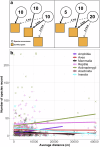Caught in statistical noise: pitfalls of a unidimensional approach to understanding biodiversity-conflict relationships
- PMID: 40325107
- PMCID: PMC12052984
- DOI: 10.1038/s44185-025-00088-4
Caught in statistical noise: pitfalls of a unidimensional approach to understanding biodiversity-conflict relationships
Conflict of interest statement
Competing interests: The authors declare no competing interests.
Figures


References
-
- Gaynor, K.M. et al. War and wildlife: linking armed conflict to conservation. Front. Ecol. Environ.14, 533–542 (2016).
-
- Rist, L., Norström, A. & Queiroz, C. Biodiversity, peace and conflict: understanding the connections. Curr. Opin. Env. Sust.68, 101431 (2024).
-
- UN OCHA. Conflict Data for Philippines (Humanitarian Data Exchange, 2023).
-
- Bautista-Cespedes, O.V., Willemen, L., Castro-Nunez, A. & Groen, T.A. The effects of armed conflict on forest cover changes across temporal and spatial scales in the Colombian Amazon. Reg. Environ. Change.21, 70 (2021).
Publication types
LinkOut - more resources
Full Text Sources

